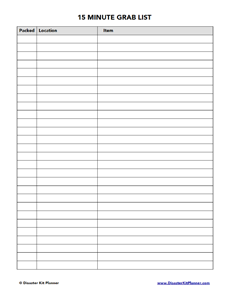Step 2 – Create an Evacuation 15 Minute Grab List
A fire is moving in your direction or rain is turning into a flash flood. You are given 15 minutes to evacuate your home. What do you pack???
Photos, keepsakes, important documents. Even if you can think of the things in your head … do you know where everything is? Imagine what would happen if you didn’t have time to think? Panic makes all of us lose focus.
Here is a great quote from Organize for Disaster by Judith Kolberg:
“Fear is a normal, natural response to danger; but fear’s effect on thinking and action can be deadly. Just when you need clear, quick thinking, your heart rate goes up. Emotions are strong. Adrenaline, a powerful hormone, is released into the body. Your brain can feel overwhelmed.”
So don’t assume you’ll be able to think clearly in an emergency. If you are only given 15 minutes to pack up your possessions, make sure you have a list of what to pack or there is a good chance you’ll forget something. Once you’ve created your list, make sure your whole family knows where to find it!
ACTION 1: Make the Evacuation Grab List now!
Organize things by room! Sure, some things will move, but most will stay in the same room. Try to have your list grouped by room so that it is faster to pack and you can delegate the lists to family members.
- Print the 15 Minute Grab List form or create a document in your favorite text editor.
 People and Pets This is the priority. Attach your Communication Plan in case family members are not home. Have a list of neighbors who are disabled or elderly (see Action 2 below). Make sure the pets are leashed and ready to go.
People and Pets This is the priority. Attach your Communication Plan in case family members are not home. Have a list of neighbors who are disabled or elderly (see Action 2 below). Make sure the pets are leashed and ready to go.- Prescriptions, vitamins and medications! This is one of the most important. Have those listed in detail with their location Include contact lens liquids and other items you’ll need at the shelter.
- Glasses and/or contact lenses
- The Bug Out Bin should be on your list. You will create one of these in Step 5. It basically holds all of the key emergency items that the Red Cross and FEMA recommend if you have to quickly evacuate or shelter in place after a disaster. These are must-have items like flashlights, radio, first aid kit, cell charger, etc. The But Out Bin keeps them organized and easy to find in an emergency.
- The next thing on the list should be the Financial Document Binder that you will create in Step 11. This will contain important documents (deeds, leases, insurance papers, certificates, etc) that you need to file applications with FEMA following a disaster.
- Purses and wallets with credit cards
- Photos, artwork, family heirlooms and irreplaceable memorabilia. LIST THESE and their locations! Don’t just write “photos” on your list. Someone else might be doing the packing. So be detailed such as: All photos on piano, photos in boxes under the bed, 6 scrapbooks on shelf in family room, etc.
- Personal Computers, laptops, hard drives with backups, disks, iPads, mobile phones
- Keys to Safety Deposit Boxes. Banks can charge a lot to replace these. Make sure they are on your list.
- Don’t forget to pack pet essentials! Make sure you include stuff you will need for them, like crates, food and bowls. I keep a flexible dog bowl in my Bug Out Bin so that all I need to do is grab the food. Check out the article, Preparing your Pets, for more information on how to make sure they are also ready for a disaster.
- Disaster Kit Binder (that you made in Step 1) if it’s not in your Bug Out Bin. This will have important FEMA brochures.
- Underwear
- Complete change of clothing for each person
- Water bottles (grab a gallon)
- Feminine supplies
ACTION 2: List of Elderly and Disabled Neighbors
It is heartbreaking to hear about the elderly and disabled who have died in the Napa fires because they were not able to escape in time. Do you have neighbors who would need assistance in an evacuation? List their names, addresses and contact numbers at the top of your Grab List. Be ready to tell officers where they live. Share this information with other neighbors and have a plan to make sure everyone gets out.
ACTION 3: Everyone knows where to find the Grab List!
Once you have created your “Grab List”, be sure other family members know where it’s located. Disasters can happen when you are not home. It may be one of your family members who has to pack the car. Have a family meeting or discuss this list at dinner. Show everyone where to find it.
ACTION 4: Join County alert system or Nixle to get alerts.
Check with your city, county or state to see if they have an alert system that notifies citizens of local emergencies. For example, Santa Clara County in California has a program called AlertSCC. It will send emergency warnings to a person’s cell phone, email or landline. See if your county has something similar.
Additionally, Nixle is an awesome web service that sends alerts from your local public safety departments and schools. You can sign up to hear about severe weather situations, criminal activities, bad traffic, missing persons and local events. You can register with Nixle by going to their website OR by texting your zip code to 888777 to opt in.

